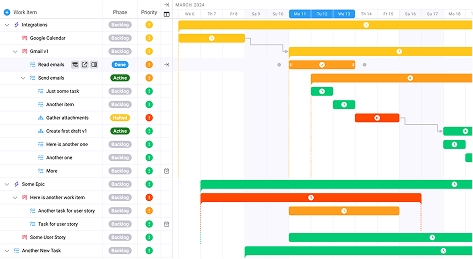
Cloud Migration Strategy: A Step-by-Step Guide for IT Service Firms
Key takeaways:
The landscape of IT service delivery is being fundamentally transformed by cloud technology, yet 90% of organizations are concerned about cloud security during migration. For IT service firms, developing a comprehensive cloud migration strategy has become not just an operational necessity, but a competitive imperative. This Cloud Migration Strategy: A Step-by-Step Guide for IT Service Firms will equip you with the frameworks, methodologies, and tactical approaches needed to execute successful migrations while maximizing client value and operational efficiency.
The Current Challenge - What's Broken in Traditional Migration Approaches
The traditional approach to cloud migration often fails IT service firms because it treats migration as a purely technical exercise rather than a strategic business transformation. The cloud migration market size is estimated at USD 232.51 billion in 2024, and is expected to reach USD 806.41 billion by 2029, yet many IT service providers are struggling to capture this massive opportunity effectively.
Current industry data reveals a concerning disconnect between migration activity and successful outcomes. While 52% of companies have migrated a majority of their IT environments to the cloud, the reality is that many of these migrations fail to deliver promised benefits due to inadequate planning and execution strategies.
The root causes of migration failures in IT service firms typically stem from three critical gaps. First, insufficient assessment and planning phases that fail to account for application dependencies, data relationships, and business process impacts. Second, inadequate security frameworks that don't address the unique risks introduced during the migration process. Third, poor change management that leaves teams unprepared for new operational models and client service delivery approaches.
More than 50% of companies use Managed Service Providers (MSPs) to oversee some or all of their public cloud workloads, creating both opportunity and pressure for IT service firms to develop sophisticated cloud migration capabilities. However, over 50% of MSPs are expected to operate within an ecosystem model by 2025, requiring new collaborative approaches to cloud strategy and delivery.
The Strategic Framework - A Comprehensive Cloud Migration Strategy Methodology
Successful cloud migration strategy for IT service firms requires a structured, phase-based approach that balances technical requirements with business outcomes. Our proven framework consists of five distinct phases: Discovery and Assessment, Strategic Planning, Migration Execution, Optimization, and Continuous Improvement.
Phase 1: Discovery and Assessment begins with comprehensive infrastructure analysis, application mapping, and dependency identification. This phase must include detailed security assessments, compliance requirement analysis, and business impact evaluations. For IT service firms, this phase also requires client consultation and expectation alignment to ensure migration activities support ongoing service delivery commitments.
Phase 2: Strategic Planning involves developing detailed migration roadmaps, selecting appropriate cloud platforms, and establishing governance frameworks. Cybersecurity considerations for small to medium IT service providers during digital transformation must be integrated throughout the planning process to ensure security remains paramount during transitions.
Phase 3: Migration Execution encompasses the actual movement of applications, data, and workloads to cloud environments. This phase requires careful orchestration of migration waves, real-time monitoring, and contingency planning. Essential IT service management practices that support successful cloud operations become critical during this phase to maintain service quality and operational excellence.
Phase 4: Optimization focuses on performance tuning, cost optimization, and security hardening post-migration. This phase often reveals the largest opportunities for operational improvements and cost savings that justify migration investments.
Phase 5: Continuous Improvement establishes ongoing monitoring, optimization processes, and evolution strategies that ensure long-term success and adaptability as business requirements change.
This comprehensive cloud migration strategy framework ensures that IT service firms can deliver consistent, predictable outcomes while minimizing risks and maximizing client satisfaction throughout the migration journey.
Implementation Tactics - Five Essential Strategies for IT Service Firms
Strategy 1: Implement Hybrid Cloud Architecture from Day One
Modern cloud migration strategy must account for the reality that 73% of enterprises have deployed a hybrid cloud strategy in their organization, with projections showing that by 2027, 90% of organizations are expected to adopt hybrid cloud strategies. For IT service firms, hybrid cloud approaches offer the flexibility to maintain critical workloads on-premises while leveraging cloud benefits for appropriate applications.
Hybrid cloud implementation requires sophisticated integration capabilities, robust security frameworks that span multiple environments, and comprehensive management tools that provide unified visibility and control. IT service firms should prioritize hybrid cloud competencies as they enable more nuanced client solutions and reduce migration risks.
Strategy 2: Develop Cloud-Native Security Frameworks
Security remains the primary concern in cloud migration initiatives, making advanced security capabilities a differentiator for IT service firms. Cloud-native security frameworks must address identity and access management, data encryption both in transit and at rest, network security, and compliance management across multiple cloud environments.
Security frameworks should also include incident response procedures, vulnerability management processes, and continuous monitoring capabilities that provide real-time visibility into security posture. For IT service firms, demonstrating advanced security capabilities builds client confidence and enables expansion into more sensitive or regulated industries.
Strategy 3: Establish Cost Optimization and FinOps Capabilities
One of the most compelling business cases for cloud migration is cost reduction. Organizations can reduce their Total Cost of Ownership (TCO) by as much as 40% by migrating to the public cloud, while IT service firms typically reduce their compute, storage, and networking costs by up to 66% after migrating to the cloud.
FinOps capabilities enable IT service firms to optimize cloud spending through automated resource scaling, unused resource identification, and cost allocation transparency. These capabilities become particularly valuable when managing multiple client environments, as they enable accurate cost attribution and optimization recommendations that directly impact client profitability.
Strategy 4: Build Multi-Cloud Management Competencies
As organizations increasingly adopt multi-cloud strategies to avoid vendor lock-in and optimize performance, IT service firms must develop competencies across multiple cloud platforms. Multi-cloud management requires platform-agnostic tools, standardized processes, and team skills that span AWS, Microsoft Azure, Google Cloud Platform, and other cloud providers.
Multi-cloud competencies enable IT service firms to offer more flexible solutions, reduce client dependencies on single vendors, and optimize workload placement based on performance, cost, and compliance requirements rather than platform limitations.
Strategy 5: Implement Comprehensive Change Management
Cloud migration represents significant organizational change that impacts technology, processes, and people. Comprehensive change management ensures that teams are prepared for new operational models, clients understand service changes, and business processes are optimized for cloud-native approaches.
Change management should include training programs, communication strategies, and support systems that ease transitions and build confidence in new cloud-based service delivery models. Strategic pricing approaches for managed IT services in the cloud era requires new pricing models and client engagement approaches that reflect cloud economics and value propositions.
Measuring Success - KPIs and Metrics That Matter
Successful cloud migration strategy requires comprehensive measurement frameworks that track both technical and business outcomes. Key performance indicators must span operational metrics, financial performance, security posture, and client satisfaction to provide complete visibility into migration success.
Technical Performance Metrics include application availability and uptime, system performance and response times, data transfer completion rates, and infrastructure utilization efficiency. These metrics provide immediate feedback on migration execution quality and identify areas requiring optimization.
Financial Performance Metrics focus on cost reduction achievements, ROI realization timelines, and operational expense optimization. Given that The Cloud Migration Market is expected to reach USD 0.30 trillion in 2025 and grow at a CAGR of 28.24%, IT service firms must demonstrate clear financial benefits to justify investments and attract new clients.
Security and Compliance Metrics include security incident frequency and severity, compliance audit results, vulnerability assessment scores, and access management effectiveness. These metrics are particularly critical given widespread security concerns around cloud adoption.
Client Satisfaction Metrics encompass service quality scores, client retention rates, new service adoption rates, and feedback scores that indicate whether cloud migration enhances or degrades client relationships.
Operational Efficiency Metrics measure team productivity improvements, service delivery speed enhancements, and automation adoption rates that indicate whether cloud migration is improving internal operations and scalability.
Establishing baseline measurements before migration begins enables accurate comparison and demonstrates concrete improvements. Regular measurement and reporting ensures that optimization opportunities are identified quickly and that cloud migration strategy continues to deliver value over time.
Future Considerations - Emerging Trends and Next Steps
The cloud migration landscape continues to evolve rapidly, with new technologies, approaches, and business models reshaping how IT service firms deliver value. Understanding emerging trends and preparing for future developments ensures that current cloud migration strategy investments remain relevant and valuable.
Artificial Intelligence and Machine Learning Integration represents a significant opportunity for IT service firms to differentiate their cloud offerings. AI-powered automation, predictive analytics, and intelligent optimization capabilities are becoming standard expectations rather than premium features. Cloud migration strategy should include plans for AI/ML capability development and integration.
Edge Computing and Distributed Cloud architectures are reshaping how applications and data are deployed and managed. IT service firms must understand how edge computing affects cloud migration strategy and develop competencies in distributed cloud management to serve clients with latency-sensitive or geographically distributed requirements.
Sustainability and Green Computing initiatives are increasingly influencing cloud migration decisions as organizations seek to reduce environmental impact and meet sustainability commitments. Cloud migration strategy should include sustainability assessments and optimization approaches that help clients achieve environmental goals while reducing costs.
Regulatory Evolution and Compliance requirements continue to evolve as governments and industries adapt to cloud-native business models. IT service firms must stay current with regulatory changes and ensure that cloud migration strategy includes compliance management capabilities that adapt to changing requirements.
Advanced Security and Zero-Trust Architectures are becoming standard requirements as cyber threats evolve and traditional perimeter-based security models prove inadequate for cloud environments. Cloud migration strategy must include advanced security capabilities and zero-trust implementation approaches.
Conclusion
The future of cloud migration strategy lies in developing comprehensive capabilities that address not just technical migration requirements, but the broader business transformation that cloud adoption enables. IT service firms that invest in advanced capabilities, maintain current expertise, and build adaptable delivery models will capture the largest share of growing cloud services demand while delivering superior client outcomes through every phase of the cloud migration journey.
Frequently Asked Questions
What is the typical timeline for cloud migration strategy implementation in IT service firms?
Most comprehensive cloud migration strategies require 6-12 months for initial implementation, with ongoing optimization continuing indefinitely. The timeline depends on infrastructure complexity, client requirements, and desired service levels.
How do IT service firms handle client data during cloud migration?
Data protection during migration requires encryption in transit and at rest, comprehensive backup strategies, detailed migration testing, and clear client communication about data handling procedures and timelines.
What are the most common cloud migration strategy failures?
The most frequent failures include inadequate assessment and planning, insufficient security frameworks, poor change management, unrealistic timelines, and inadequate post-migration optimization.
How should IT service firms price cloud migration services?
Cloud migration pricing should reflect the complexity of assessment, planning, execution, and ongoing support phases, while accounting for client-specific requirements and risk levels.
What certifications should IT service firms pursue for cloud migration?
Key certifications include AWS Solutions Architect, Microsoft Azure Solutions Architect, Google Cloud Professional Cloud Architect, and CompTIA Cloud+ for broad cloud competencies.
How do hybrid cloud strategies affect client service delivery?
Hybrid cloud approaches enable more flexible service delivery options but require advanced management capabilities and integration expertise to maintain consistent service quality across environments.
What role does automation play in successful cloud migration strategy?
Automation reduces migration risks, accelerates deployment timelines, improves consistency, and enables more cost-effective service delivery, making it essential for scalable cloud migration capabilities.
How often should cloud migration strategy be updated?
Cloud migration strategy should be reviewed quarterly and updated annually to account for technology evolution, regulatory changes, client requirement shifts, and business model adaptations.








